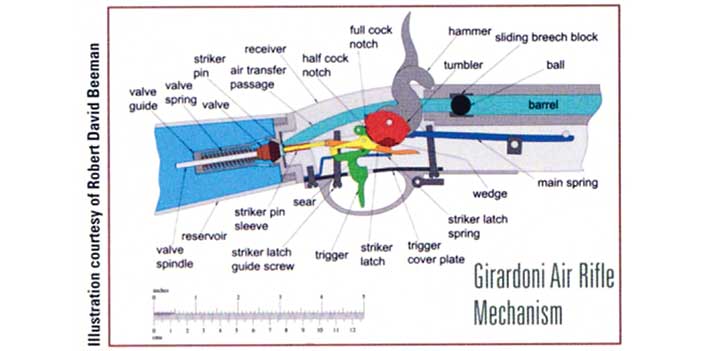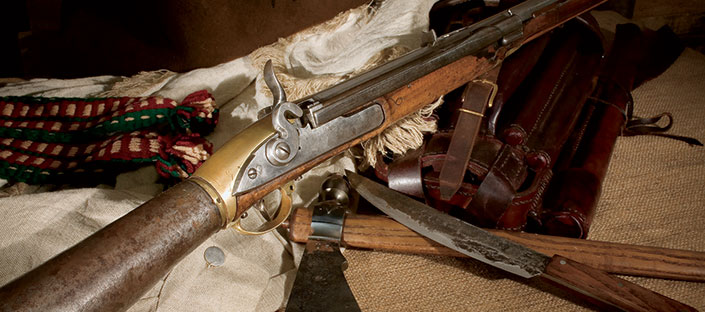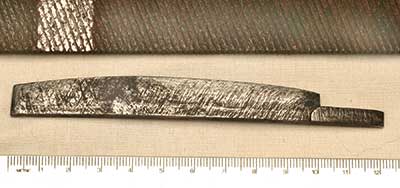
Originally published in October, 2006
 It has been 200 years since the members of the cross-country Corps of Discovery returned triumphant to St. Louis, Mo., with tales of their three-year exploration of the Northwest United States. Popularly known as the Lewis & Clark Expedition, the intrepid band of soldiers, guides and hunters made the journey to the West Coast and back with the loss of only one life. They gained an immeasurable knowledge of the great West and claimed more territory for our flag than any event since the Declaration of Independence.
It has been 200 years since the members of the cross-country Corps of Discovery returned triumphant to St. Louis, Mo., with tales of their three-year exploration of the Northwest United States. Popularly known as the Lewis & Clark Expedition, the intrepid band of soldiers, guides and hunters made the journey to the West Coast and back with the loss of only one life. They gained an immeasurable knowledge of the great West and claimed more territory for our flag than any event since the Declaration of Independence.
Among their greatest contributions to history are their famous journals. On the very first page, in Meriwether Lewis’ first entry of what eventually totaled three year’s worth of notes, he wrote:
August 30, 1803. “Left Pittsburgh this day at 11’o clock … went on shore and being invited on by some of the gentlemen present to try my airgun which I had purchased brought it on shore charged it and fired myself seven times fifty five yards with pretty good success; after which a Mr. Blaze Cenas being unacquainted with the management of the gun suffered her to discharge herself accidentally the ball passed through the hat of a woman about 40 yards distance cutting her temple about the fourth of the diameter of the ball; she fell instantly and the blood gushing from her temple we were all in the greatest consternation supposed she was dead by [but] in a minute she revived to our inespressable satisfaction … .”
We can see from this first entry that an airgun was the center of excitement and controversy from the outset of the expedition. Not much has changed in the past 200 years. At different times over just the past 50 years, no less than four institutions have claimed they hold the original airgun in their collections.

The search for the original airgun from the expedition has lead to some interesting places. The earliest claimant was a ball-reservoir type airgun donated to the Smithsonian Institution in 1957. The donor believed he had the original airgun based on what he had read in the journals.
Capt. Lewis. Monday, June 10, 1805.“ ... Shields renewed the main Spring of my air gun we have been much indebted to the ingenuity of this man on many occasions; without having served any regular apprenticeship to any trade, he makes his own tools principally and works extremely well in either wood or metal, and in this way has been extremely serviceable to us, as well as being a good hunter and an excellent waterman.”
This passage has been the subject of much speculation over the years and yet may be one of two key passages that help identify the original airgun. The donor theorized the mainspring repair was actually a solder job to the copper-ball reservoir on the underside of the gun. In an article published only months earlier, he had originally identified an Isaiah Lukens-marked airgun that is at the Virginia Military Institute Museum, as “The Lewis & Clark air gun.” Thus began 50 years of controversy.
Scholars of the expedition have always looked to the journals for clues as to the style and type of guns used on the expedition. The most recent editor of the journals is Dr. Gary E. Moulton. His editions, numbering 13 volumes and more than 1 million words, are considered to be the single most comprehensive account of the expedition.
The 2001 publication of the journals was popularly received by the large community of Lewis & Clark aficionados. Among those writing about the firepower of the expedition was a staff editor of Gun Report, Michael Carrick. Carrick delved into the journals, read all 13 volumes and made copious notes on any mention of the firearms used on the expedition.
Through a conversation with a fellow Lewis & Clark historian, Carrick was introduced to a most extraordinary manuscript, the diary of Thomas Rodney. Rodney was the brother of Delaware’s Caesar Rodney, a signer of the Declaration of Independence. In September 1803, he went west to assume a judgeship as an appointee of President Thomas Jefferson. On Sept. 8, 1803, Rodney’s and Lewis’ paths crossed in Wheeling, Va. (current West Virginia was then part of Virginia). And Lewis made note of the meeting in his journals.

Capt. Lewis. Sept. 8, 1803.“ ... dined with Colo. Rodney.”
Fortunately, Rodney was a bit more verbose about the encounter.
Thomas Rodney. Sept. 8, 1803. “Visited Captain Lewess barge. He showed us his air gun which fired 22 times at one charge. He showed us the mode of charging her and then loaded with 12 balls which he intended to fire one at a time; but she by some means lost the whole charge of air at the first fire. He charged her again and then she fired twice. He then found the cause and in some measure prevented the airs escaping, and then she fired seven times; but when in perfect order she fires 22 times in a minute. All the balls are put at once into a short side barrel and are then dropped into the chamber of the gun one at a time by moving a spring; and when the trigger is pulled just so much air escapes out of the air bag which forms the breech of the gun as serves for one ball. It is a curious piece of workmanship not easily described and therefore I omit attempting it.”
The airgun that Rodney described was unique enough to be instantly recognizable as the type designed by C.G. Girandoni and adopted by the Austrian military in the late 1700s. Girandoni was an inventor and designer who seemed to have a fascination with repeating firearms. He is now best known for his repeating airgun that was adopted by the Austrian army. The description of a Girandoni is unique to airgun mechanisms. The gun had a buttstock that also served as an air reservoir. This small air tank held 800 p.s.i. of air pressure delivered by a rod-piston pump device that took close to 1,500 strokes to reach capacity. On the right side of the rifled barrel was attached a small tubular magazine that held 22 .46-cal. lead balls. Gravity fed them into a sliding breech block held taut by a straight leaf spring. By flicking his thumb and forefinger against the breech and cocking the hammer with his off hand, the shooter could load and fire the 22 shots in under a minute, just as described by Rodney.

Airguns were nothing new in 1800. Some histories date them as early as 1560, but they were complicated and expensive to produce. Until Girandoni, their use in any numbers seemed impractical. It is estimated that the Austrians produced 1,500 airguns for use against Napoleon. Each soldier was equipped with a number of pre-primed air reservoirs and magazine tubes, each with 22 rounds of ammo. A battalion of men armed with such repeating rifles could lay down a devastating field of fire.
For collectors and historians alike, Carrick’s discovery was exciting news. The Girandoni system and its links to the Napoleonic Wars—and now the Corps of Discovery—made for fascinating conjecture.
Among those who have spent whole segments of their lives studying the history of the expedition of Lewis & Clark was Stephen Ambrose, a gifted historian and publicist. He had a personal obsession that intrigued him his entire life: the expedition of the Corps of Discovery. That interest culminated in his 1996 book Undaunted Courage.
Ambrose seldom asked questions that he was unable to answer. Yet in Undaunted Courage, he asked the same question, not once but three times: How could a relatively small expedition of soldiers and hunters travel so formal dress parade to greet them with uniforms brushed and the Stars and Stripes flying overhead. They presented the chiefs with gifts, and Clark would make a speech welcoming them into the family of the great white father in Washington. And then, according to Sgt. Ordway, “ … Capt. Lewis Showed them the air Gun. Shot it Several times.”
There are 39 passages in the journals where Lewis runs through the same routine. Each nearly always ends with the same observation. On writing about the airgun the journals record the reactions as having “astonished the natives,” and “the air gun astonished them very much,” as well as:
Capt. Lewis. Aug. 17, 1805. “[W]e communicated to them fully the objects which had brought us into this distant part of the country ... [W]e made them sensible of their dependance on the will of our government for every species of merchandize as well for their defense & comfort; and apprized them of the strength of our government. … [W]e also gave them as a reason why we wished to petrate the country as far as the ocean to the west of them was to examine and find out a more direct way to bring merchandize to them. … that it was mutually advantageous to them as well as to ourselves that they should render us such aids as they had it in their power to furnish in order to haisten our voyage and of course our return home. … I also shot my air-gun which was so perfectly incomprehensible that they immediately denominated it the great medicine.”

When meeting new groups of Indians, Lewis had the above routine worked out. Most importantly, he showed them the airgun because it amazed them to great wonderment. It was Lewis’s parlor trick—his slight of hand to intimidate the Indians into thinking that the explorers were even more powerful than they seemed. The Indians, to whom Lewis never exposed the full contents of his boat or any of his supplies, never knew if the expedition had one or 40 airguns.
To think that 30 or so explorers could lay down 22 shots with great accuracy within seconds must have impressed the Indians into a state of cooperation. Lewis traveled the west with an ace up his sleeve in the form of the repeating airgun. Only the Girandoni air rifle is capable of obtaining the results that Lewis got from the Indians. The party was never molested in force, and all but one man returned to St. Louis in 1806.
To answer Ambrose’s question, Lewis & Clark survived the trip, explored the West, added to the map of the United States twice its previous territory and made friends of the Indians by following the golden rule of diplomacy—peace through superior firepower! (Or at least the perceived impression of superiority.)

It May Be The One …
My obsession with the Lewis & Clark airgun caught the attention of two friends from Chambersburg, Pa., Rick Keller and Ernie Cowan, who became instantly taken by the Girardoni system. They contacted another friend of mine, Dr. Robert Beeman of California, and sought to borrow the Austrian military Girardoni from his collection for study. They were eventually given permission to take the gun apart to enable them to examine and copy the mechanism for a reproduction they planned to craft by hand. Upon examination of the inner workings of the gun, they discovered that the mainspring was unlike any previously encountered. It was a flat mainspring, not a “V” spring as we are most familiar with. Upon closer examination, it was discovered that the spring was not original to the gun. It was a crudely shaped spring that bore traces of cross-hatch marks that indicated that it had been made from a farrier’s file!
Could this be the actual airgun from the Corps of Discovery, the one John Shields, the expedition’s farrier and blacksmith, repaired on June 10, 1805, as described in the journals? We may never be 100 percent sure, but the circumstantial evidence is overwhelming. This topic and numerous other examples that may link this very gun to the expedition can be found online at www.beemans.net.
—Philip Schreier






































